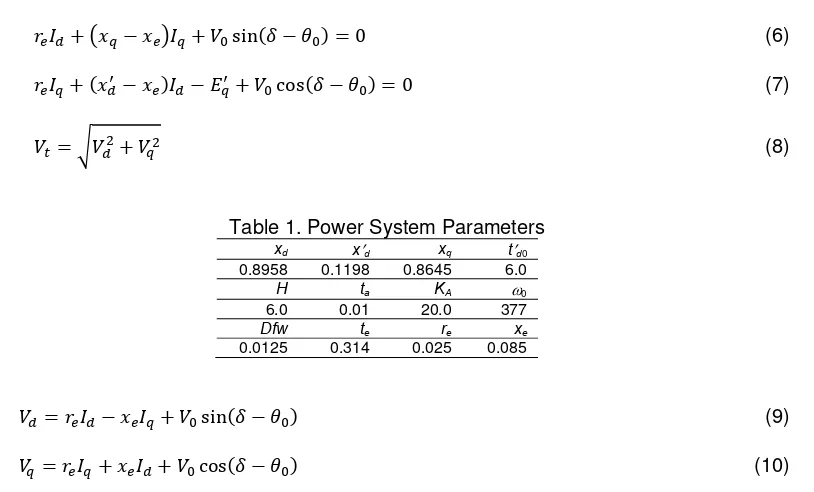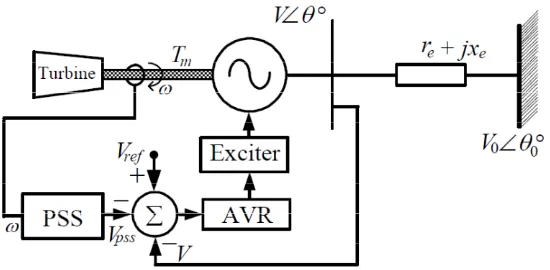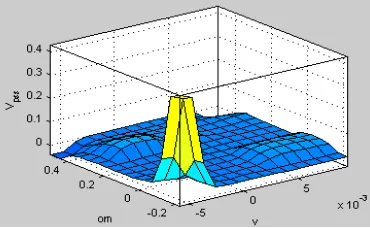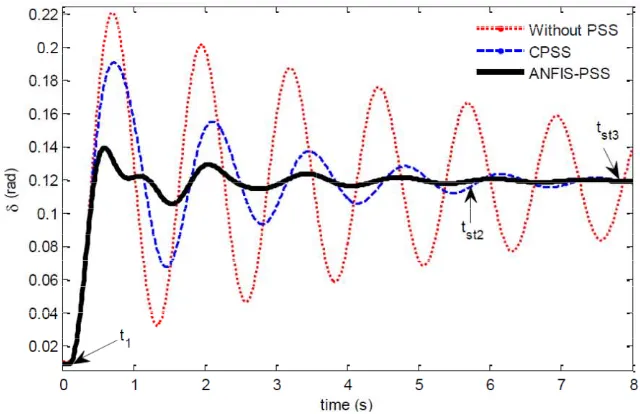DOI: 10.12928/TELKOMNIKA.v12i2.1977 315
Stability Improvement of Single Machine using
ANFIS-PSS Based on Feedback-linearization
I Made Ginarsa1, Osea Zebua2
1
Dept. of Electrical Engineering, Mataram University Jln. Majapahit No. 62 Mataram, Telp/fax+62 370 636755
2
Dept. of Electrical Engineering, University of Lampung
Jln. Prof. SumantriBrojonegoro No. 1, Bandar Lampung, Telp. +62 721701609 *Corresponding author, e-mail: [email protected]; [email protected]
Abstract
Electrical power system (EPS) operation always follows load changes which occur within time. Load changes and disturbances cause EPS operation to find a new balance point and before can reach the new balance point, the rotor speed will swing around its synchronous speed. This phenomenon causes the stability of the EPS operation decrease significantly, moreover, when the disturbance is large the machine tend to become unstable. To overcome this problem, it is necessary to add a power system stabilizer (PSS). This research proposes ANFIS-PSS based on feedback-linearization to stabilize the EPS operation. Feedback-linearization is a nonlinear control technique which feedback and limits several outputs in order to make the nonlinear system acts as a linear system. Data from conventional PSS is used to train and to update ANFIS-PSS parameters. Simulation results show an improvement of the stability of single machine model such as decreasing in maximum magnitude of rotor speedat the value of 0.466 rad/s and to reduce the time settling to 5.6 s.
Keywords: stability, PSS, ANFIS, feedback-linearization, settling time reducing
1. Introduction
Electric power systems have intrisically naturaland should be modelled using a nonlineardifferential equation.Conventional linear control has limited ability, so it is able to stabilize a plant due to dynamic (small) disturbance and work with one point operation only [1].Some efforts have been done to reduce the rotor oscillation in power systems by using power system stabilizer (PSS) based on neural network (NN), such as,heuristic-dynamic-programming [2], adaptive NN [3] and recurrent NN [4].Nonlinear control scheme was applied to control steam turbine valve in a multimachine power system using the geometrical differential method [5]. So, stabilization of a multimachine power system via excitation control using decentralized feedback-linearization was able to reduce rotor oscillation against dynamic and transient disturbances. Input signal control was observed by local measurement only [6]. PSS design using feedback-linearization in nonlinear power system model by considering the magnitude limit of control signal have been done by Liu et al. [7]. Robust control technique via Lyapunov method was used to improve the stability of a nonlinear power system when the power system was forced by heavily disturbances [8].
reactance ( ). Steam or gas turbine function convertsthermal energy to mechanical energy or torque (Tm). Synchronous generator produces terminal voltage (V)at a bus machine through excitation system. Single machine connected to infinite bus is expressed by formula Eqs.(1)-(5).
(1)
(2)
(3)
(4)
(5)
where Tm, , , 0, D and M are the mechanical torque, rotor angle, rotor speed, synchrounous speed, damping constant and inertia constant, respectively.Thevariabels Id, Iq and Vt are constrained by Eqs. (6)-(8), respectively.
sin (6)
cos (7)
(8)
Table 1. Power System Parameters
xd xd xq td0
0.8958 0.1198 0.8645 6.0
H ta KA 0
6.0 0.01 20.0 377
Dfw te re xe
0.0125 0.314 0.025 0.085
sin (9)
cos (10)
Figure 1. Single-machine model equipped by PSS.
3. ANFIS-PSS Based on Feedback-linearization Design 3.1. Feedback-linearization method
Nonlinear control technique feedback-linearization method is a technical procedure that state feedback of a nonlinear system, where some outputs of the system are bounded (constrained). This method made the system behave as a linear system [19]. When some of variables such as Id, Iq and Vt, are not state variables, a transformationis needed to make that variables became state variables. Single machine model that expressed by variables in Eqs. (2)-(5) is transformed into the model that expressed by variables in Eqs. (11)-(14).Part from this, the state variable () in Eq. (1) is still the same.
sin cos sin cos sin ′
cos ′ ′ (11)
′ ′ sin ′ cos (12)
(13)
(14)
where .In addition, definition of constants from k1 to k28 are given in Appendix B.
3.2 Linearization processes of input-output controller
The single machine which is connected to theinfinite bus is a single input-single output (SISO) nonlinear control problem. In this research, speed rotor () variable is used as an object control.By defining , the control objective is regulated toward zero value. To obtain the rotor speed deviation (e) that connect to control signal (u) it isrequired to differentiate
eseveral times until the control signal (u) is appeared. Derivative processes are shown as follows:
(15)
(16)
(17)
(18)
Derivative process of the error from to aregiven in Appendix A. Variabel
Xis initial state variable which consists ofrotor angle (),rotor speed (),quadrature axis voltage
Figure 2. Feedback-linearizationcontrol technique that was implemented in single machine model.
(19)
̅ ̅ ̅ (20)
where T is vector transpose. The dynamics of the system are expressed as follows:
(21); (22); (23)
(24)
In this research, the line frequency (f) is 60 Hz. So, 0is a constant value at 260 = 377 rad/s. Therefore, all of its derivatives have zero values. Ideal control signal vwas chosen as follow:
̅ (25)
Where Kv is the gain vector. , where a1, a2, a3 and a4 are the parameters of the gain vector. The parameters a1, a2, a3 and a4are chosen properly to make the closed-loop system stable. Then, theclosed-loop dynamical system was transformed into a linear system without magnitude constraint (u = v).
̅ ̅
̅ (26)
By choosing the parameters a1, a2, a3 and a4properly, the system in Eq. (26) tendsto asymptotically stable (e0). Since the actual control signal is a subjec to magnitude contraints,
the applied control signal (u) is given by
| |
| | (27)
3.3. ANFIS-PSS Design Processes
An ANFIS-PSS was designed using ideal control signal (v)and rotor speed as inputs, and control signal from PSS as the output. Each inputs of the ANFIS-PSS have five membership functions. The membership function that used to state each inputs are Gauss type 2 membership function. Each inputs used five linguistic variabels such as: negative high (NH), negative low (NL), zero (ZE), positive low (PL) and positive high (PH) to express the value of the input signal. Fuzzy model Takagi-Sugeno (T-S) is used to implement the fuzzy inference system.The output of the ANFIS PSS is a signal control (Vpss) and 25 rules with linear membership function are used to implement the output signal.
Learning stages are done by using off-line method with 4000 data matrix input-outputs. In this stage the data is structured in matrix form as [vVpss], where v, , are the input signal control ideal and input rotor speed, respectively. Vpss is the output control signal from ANFIS-PSS.The proposed ANFIS-PSSis applied to a single machine connected to infinite bus as shown in Figure 3.Architecture and input-output surface control of ANFIS-PSS are shown in Figure 4 (a) and 4 (b), respectively.
Figure 3. Implementation of the ANFIS-PSS to improve stability of single machine.
Figure4 (a). Architecture of fuzzy Sugeno with two input (v,) and one output (Vpss).
oscillate.This oscillation can be occured because the system naturally has insuffiction damping component to damp the rotor oscillation when the system is disturbed. Next, ANFIS-PSS is proposed to produce an additional signal. This additional signal is used to modulate the automatic voltage regulator (AVR) to produce damping torque component through the exciter system. So, the damping torque component is used to damp the rotor oscillation. And, the response of the proposed controller is also compared to the response of conventional PSS (CPSS) in order to valid of the simulation result.
Maximum magnitude, time of the maximum magnitude occurred and settling time ofthe CPSS response was achieved at the value of 0.492 rad/s, time of 0.37 s and 7.89 s, respectively. Meanwhile, the response of the proposed controller was achieved at the value of 0.466 rad/s, time of 0.33 s and 5.6 s, for the maximum magnitude, time of the maximum magnitude occured and settling time, respectively.It is shown that the proposed controller is able to reduce the maximum magnitude and settling time of the rotor speed response. The response of the proposed controller is better than the other controllers.
Figure 6. Control signals produced by the conventional PSS and ANFIS-PSS.
Figure 7. Responses of rotor angle for respective controllers.
Figure 6 shows the signal control pattern (u(Vpss)) from CPSS and the proposed PSS. This signal was used to modulate AVR in the excitation system.It is shown that the maximum magnitude (u(Vpss)) of the signal control was less than the magnitude constraint (umaks = 0.5 pu). The control signal that produced by the PSS is bounded.By this result it is guaranteed that the system is stable.
angle.
References
[1] Guo Y, Hill DJ, Wang Y. Nonlinear decentralized control of large-scale power systems. Automatica, Pergamon. 2000; 36: 1275-1289.
[2] Liu W, Vanayagamoorthy GK, WunschDC II. A heuristic-dynamic-programming-based power system stabilizer for a turbo generator in a single-machine power system. IEEE Trans. on Industry Application. 2005; 41(5): 1377-1385.
[3] Liu W, Vanayagamoorthy GK, Wunsch DC II. Adaptive neural network stabilizer design. IEEE Conference. 2003: 2970-2975.
[4] Ariwibowo W. Stabilisator sistem tenaga listrik berbasis jaringan syaraf tiruan berulang untuk sistem mesin tunggal. Telkomnika. 2010; 8(10): 65-72.
[5] Lu Q, Sun YZ. Nonlinear stabilizing of multimachine systems. IEEE Trans. on Power Systems.1989; 4(1): 236-241.
[6] Chapman JW, Ilic MD, King CA, Eng L, Kaufman H. Stabilizing a multimachine power system via decentralized feedback linearizing excitation control. IEEE Trans. on Power Systems.1993; 8(3): 830-839.
[7] Liu W, Vanayagamoorthy GK, Wunsch dan DC II. Feedback linearization based power system stabilizer with control limits. Dept. of Electrical and Computer Engineering, University of Missouri-Rolla. USA.
[8] Jiang H, Cai H, Dorsey JF. Toward a globally robust decentralized control for large-scale power systems. IEEE Trans. on Control Systems Tech. 1997; 3(5): 309-319.
[9] Ginarsa IM, SoeprijantoA, Purnomo MH. Controlling chaos using ANFIS-based composite controller (ANFIS-based CC) in power systems. Proc.ofInt. Conf. ICICI-BME, Bandung. 2009.
[10] Ginarsa IM, Soeprijanto A, Purnomo MH, Syafaruddin, Hiyama T. Controlling voltage collapse using ANFIS-based composite controller-SVC in power systems. Proc. of TENCON 2011 Conf., Bali. 2011: 275-279.
[11] Ginarsa IM, Soeprijanto A, Purnomo MH. Controlling chaos and voltage collapse using ANFIS-based composite controller-static var compensator in power systems. Int. Journal of Electrical Power and Energy Systems (IJEPES). 2013; 46: 79-88.
[12] Ginarsa IM, Soeprijanto A, Purnomo MH, Syafaruddin, Hiyama T. Improvement of transient voltage responses using an additional PID-loop on ANFIS-based CC-SVC to control chaos and voltage collapse in power systems. Proc. of 5th ICAST conf., Kumamoto University, Japan. 2010.
[13] Ginarsa IM, Soeprijanto A, Purnomo MH, Syafaruddin, Hiyama T. Improvement of transient voltage responses using an additional PID-loop on ANFIS-based composite controller-SVC (CC-SVC) to control chaos and voltage collapse in power systems. IEEJ Trans. on Power and Energy. 2011; 131(10): 836-848.
[14] Gholipour A, Lesani H, Zadeh MK. Performance of a ANFIS based PSS with tie line active power deviation feedback. Proc. of Int. Conf. on PEITS. 2009; 2: 267-273.
[15] Mitra P, Chowdhury S, Chowdhury SP, Pal SK, Song YH, Taylor GA. Damping local and inter-area oscillations with adaptive neuro-fuzzy power stabilizer. Proc. of Int. Conf. on UPEC. 2006; 2: 457-461.
[16] Ginarsa IM, Muljono AB, Nrartha IMA. Controlling Chaos and Voltage Collapse using Layered Recurrent Network-based PID-SVC in Power Systems. Telkomnika. 2013; 11(3): 451-462.
[17] Harikrishna D, Srikanth NV. Dynamic stability enhancenment of power systems using neural-network controlled static-compensator. Telkomnika. 2012; 10(1): 9-16.
[19] Cheng D, Tarn TJ, Isidori A. Global External Linearization of Nonlinear Systems Via Feedback. IEEE Trans. on Automatic Control. 1985; AC-30 (8): 808-811.
[20] MATLAB Version 7.9.0.529 (2009b). The Language of Technical Computing. The Matworks Inc. 2009.
Abbreviation and Symbol
ANFIS Adaptive neuro-fuzzy inference system H Inertia constant AVR Automatic voltage regulator td0 Direct-axis time constant
PSS Power system stabilizer 0 Initial rotor angle
CPSS Conventional PSS e Error signal
re network resistance u (Vpss) Control signal
xe Network reactance v Ideal control s
Appendix A:
Feedback-linearization
For the sake of simplicity the variabel
sin cos sin cos sin cos (A1)
Constant calculationk1- k28
′ ; ′ ;
′
; ;





